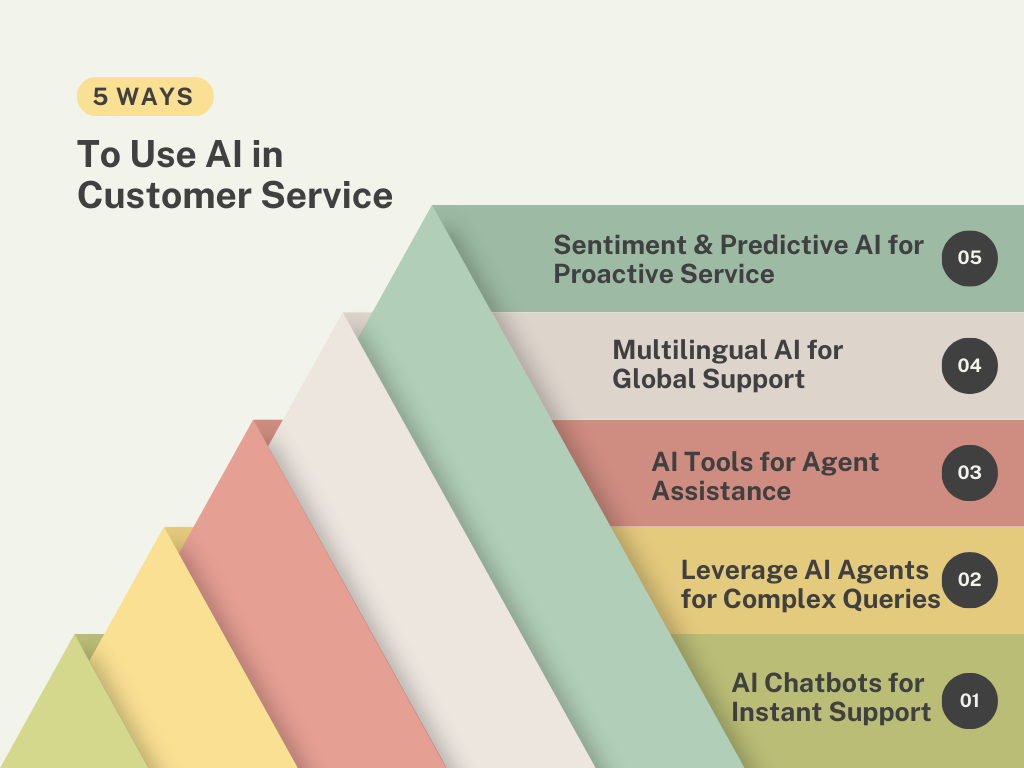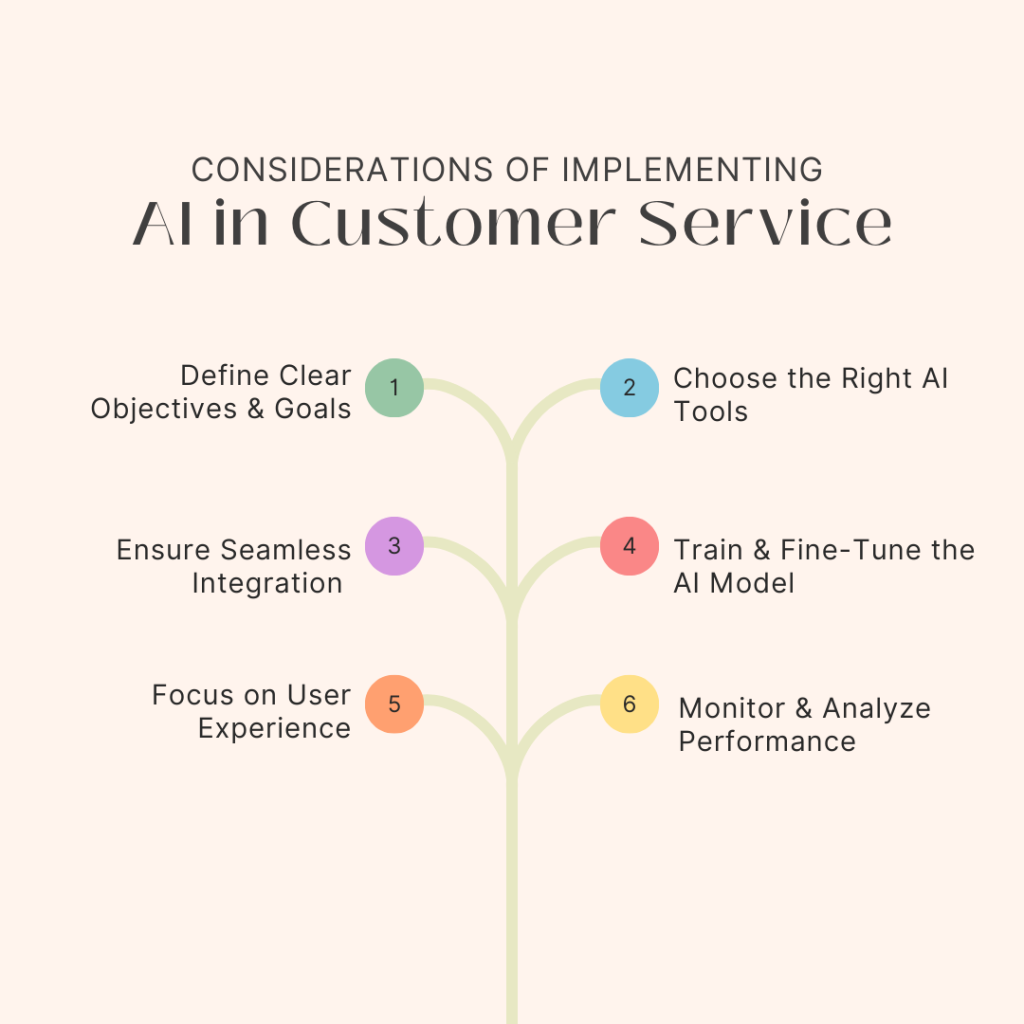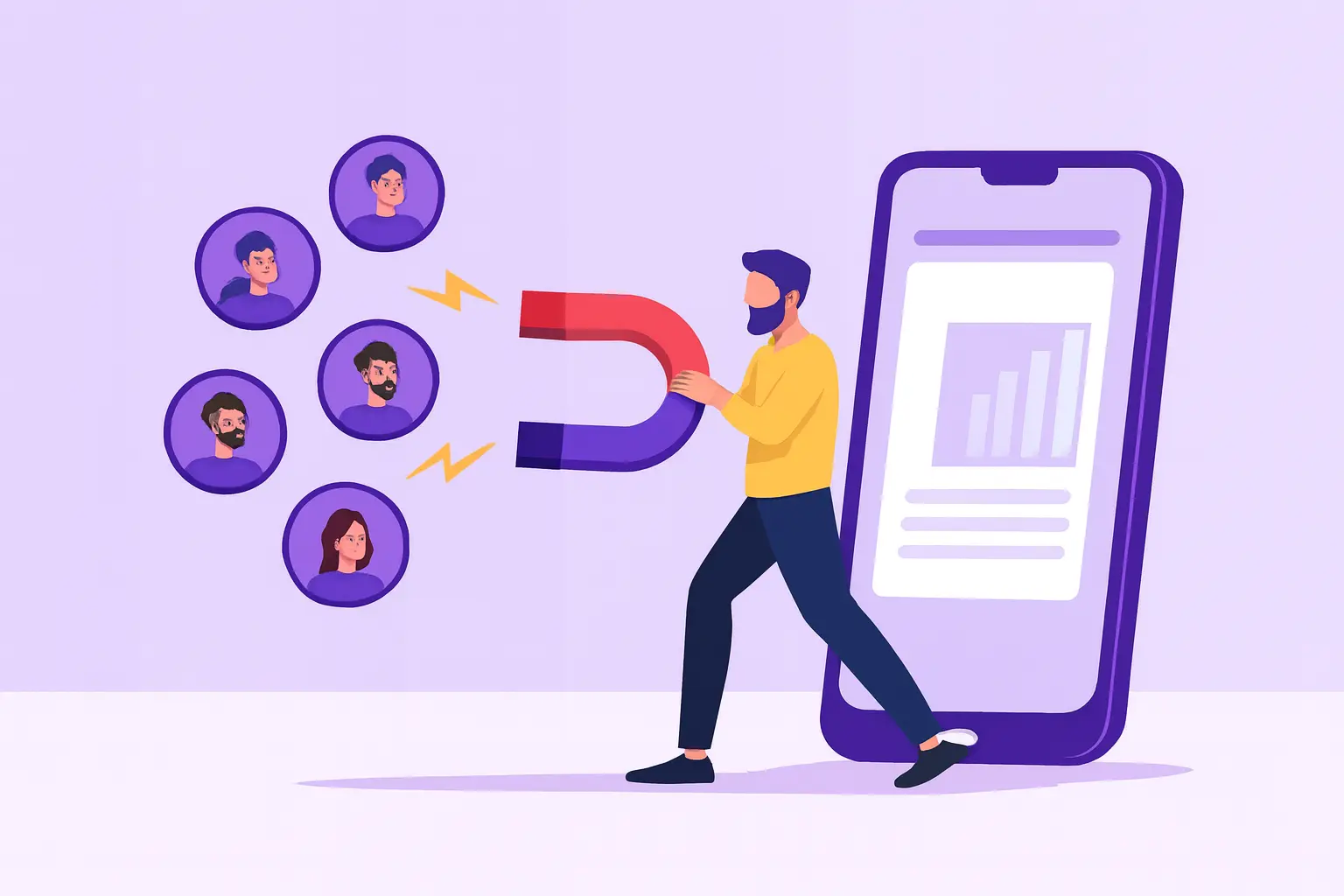AI in Customer Service: Benefits, Strategies & Examples
- December 1, 2025
- 19 mins read
- Listen

Customer service has always been about people — their needs, questions, worries, and moments of confusion. But today, there’s a quiet revolution happening behind the scenes. AI, once a distant buzzword, is gently weaving itself into the way businesses listen, respond, and care for their customers.
This blog is here to walk you through that change — with heart, not hype.
We’ll explore what AI in customer service really means, how it’s helping support teams every day, and the ways you can thoughtfully bring it into your customer service. Whether you’re a curious beginner or someone planning a deeper transformation, this guide is made for you, not to overwhelm, but to support.
What is AI in Customer Service?
AI in customer service is simply about using intelligent technology to make support smarter, faster, and more helpful for both customers and the teams behind the scenes. AI leverages machine learning, natural language processing (NLP), and data analytics to understand customer queries, provide instant responses, and improve overall service efficiency.
One of the most familiar examples of this is the chatbot. Many of us have chatted with these helpful assistants, whether to check an order status or get quick answers. AI-powered chatbots are designed to simulate natural conversation and can handle a wide range of tasks, from simple FAQs to more complex support flows.
AI in customer service examples
AI delivers faster responses, better support and more personalized experiences. In fact, a 17% increase in customer satisfaction was recorded by mature AI adopters, or businesses that use or optimize AI in their customer service operations.
Here are several instances and use cases of how companies apply AI to enhance customer service, along with the AI tools and technology that enable each:
Instant response
When you ask a query on a website and get an answer instantly that’s usually a chatbot. AI-powered chatbots deliver instant answers to common customer issues, walk customers through procedures or help troubleshoot difficulties any time of day. An average incoming call handling time reduction of 38% was recorded by mature AI adopters.
Chatbots are constructed using natural language processing (NLP)—which allows them to interpret and respond to human language—and machine learning (ML). Without the need for manual updates, the NLP enables them to grow over time by learning from previous client interactions.
Virtual customer assistants (VCAs)
Basic chatbots are not as advanced as VCAs. Often used in e-commerce, VCAs are found in mobile apps or smart gadgets that use conversational AI, which mixes NLP and ML to produce human-like interactions. More complicated duties, such as placing orders, handling account problems, or providing product recommendations, can be handled by a virtual AI agent, often via both speech and text.
Intelligent routing of customer questions
AI can automatically categorize client inquiries and direct them to the best person or team. While predictive analytics relies on data patterns to predict a message’s topic or urgency and instantly forward it to the appropriate person, machine learning examines past behaviors and results.
Predictive customer support
When something is wrong, such as strange account activity or a service that is about to expire, AI can identify it and move to assist clients before they become aware of it. Predictive analytics looks at your past behavior and compares it to real-time patterns to figure out what you might need next, such as a subscription renewal reminder or help with a product.
Customer sentiment and emotion detection
AI systems are able to figure out the sentiment and tone of a customer’s message. Using sentiment analysis technologies, they examine verbal cues to identify how someone feels, whether they’re furious, frustrated or happy. This feature lets companies respond faster to angry consumers and manage challenging conversations with more care.
Personalized self-service tools
Instead of a consumer going through endless support pages or FAQs, AI may offer the exact guide, video or solution they need based on what they searched for, viewed or paid. These systems rely on recommendation engines, which are algorithms trained to identify preferences and propose related resources.
Smart knowledge management
AI can scan, identify and organize massive libraries of support content, providing a knowledge base to help both customers and support personnel locate accurate answers quickly. Using machine learning, it learns which articles are most beneficial. Some systems uses generative AI to rapidly build individualized assistance text or summaries.
Quality monitoring and agent coaching
AI evaluations enable real-time conversations to identify any problems, like policy infractions or disgruntled clients. These solutions assist managers in coaching agents and resolving issues as they arise by utilizing machine learning and real-time information.
Voice recognition and upgraded IVR systems
Automated phone systems can comprehend spoken language thanks to AI-powered voice recognition. Interactive voice response (IVR) systems allow customers to communicate their issue naturally instead of putting them through endless “press 1, press 2” choices. These solutions enhance contact center efficiency and make phone support more user-friendly and less annoying when combined with conversational AI.
4 Key Benefits of AI in Customer Service
AI in customer service has a lot of benefits. It improves efficiency, enhances customer experience, reduces costs, provides data-driven insights, and more. Let’s break down the advantages of AI in customer service.
1. Enhanced Efficiency & Scalability
One of the major benefits of AI in customer service is that AI improves efficiency and scalability. When AI is implemented well, it relieves pressure from the support team.
Automation of Repetitive Tasks
AI automates the task in customer service. Think password resets, order tracking, store hours, the kind of questions that don’t need a human to answer. AI handles them consistently and instantly, which frees up agents for higher-value conversations.
When I’m talking about AI, I’m referring to AI-powered Chatbots that can handle routine inquiries.
24/7 Availability
Another advantage of AI in customer service is that the Chatbot can provide 24/7 customer support. You know very well that customers don’t always reach out during working hours. And expecting agents to cover nights and weekends just isn’t scalable. You can use AI to fill in the gap.
AI can provide basic support any time of day and hand it over to a human when necessary.
This constant availability enhances customer satisfaction and loyalty. A Statista survey revealed that 82% of consumers would use a chatbot instead of waiting for a customer representative.
Faster Response Times
Waiting is one of the biggest sources of frustration in customer service. Unlike human teams that can get overwhelmed during peak times, AI handles hundreds of conversations at once. It maintains fast, reliable response times. This keeps service levels high, even when demand spikes.
Scalability
One of the underrated benefits of AI in customer service is that it doesn’t need training every time your ticket volume spikes. As your business grows, so do your support needs. AI scales effortlessly without the challenges of hiring, onboarding, or scheduling. Whether it’s a seasonal rush or a product launch, AI adjusts in real time so your team doesn’t have to scramble.
2. Improved Customer Experience
Another key benefit of AI in customer service is that AI improves customer experience and satisfaction. There’s a common fear that AI makes things feel robotic or impersonal. But when done right, it can actually make customer interactions smoother and more thoughtful.
Personalized Interactions
AI provides personalized communication with your customers. These tools can access a customer’s past purchases, chat history, or preferences and use that context to deliver more helpful responses. It saves the customer from repeating themselves, which makes a big difference in how the interaction feels.
Proactive Support
A good AI system doesn’t just wait for the customer to reach out. It can detect friction points like a user stuck on checkout and offer help at just the right time. These proactive touches create a smoother journey and can reduce drop-offs or shopping abandonment carts.
Seamless Omnichannel Support
Customers might message you on Facebook, email, and live chat — all in the same day. AI helps unify those conversations so it doesn’t feel disjointed. From the customer’s perspective, it’s one continuous conversation.
Multilingual Support
If you serve a global customer base, multilingual AI support can really open doors. It doesn’t replace native-speaking agents in complex cases, but it effectively bridges the gap for general queries.
3. Cost Reduction & Resource Optimization
AI reduces costs and optimizes resources, which is another benefit of AI in customer service. It’s easy to talk about cost savings, but the more strategic impact of AI is how it helps you use your resources better.
Operational Cost Savings
You don’t need as many agents handling repetitive tickets, which saves on headcount, especially during high-traffic seasons. And this reduces the operational cost and saves a lot of fortune for your business.
Reduced Agent Workload
When AI filters out the low-complexity queries, your team can focus on the conversations that require empathy, negotiation, or creative problem-solving. And honestly, most support agents want to do that kind of work.
Improved Resource Allocation
With AI analyzing patterns, you can forecast when your team will be most needed, what types of issues are coming in, and where to allocate time and budget more effectively.
Lower Training Costs
Since agents aren’t spending as much time on basic queries, you can tailor training around advanced scenarios, improving quality without overwhelming the team.
4. Data-Driven Insights & Decision-Making
Finally, AI in customer service benefits from the data-driven insights, which ultimately lead to decision-making. Customer support has always generated a lot of data, but AI turns that into something actionable.
Customer Behavior Analysis
AI can analyze thousands of interactions and spot trends you might miss, like common friction points in your checkout flow or product issues customers keep mentioning.
Predictive Analytics
Imagine knowing which customers are likely to churn or what products to recommend based on past behavior. AI makes this possible by forecasting outcomes, helping businesses make smarter decisions ahead of time.
Sentiment Analysis
AI doesn’t just read words, it picks up on tone and emotional cues. If a message sounds angry or urgent, AI can route it to a senior agent or trigger an alert. This helps protect relationships and defuse situations before they escalate.
Performance Monitoring
AI-powered dashboards provide up-to-the-minute visibility into metrics like response time, resolution rate, or customer satisfaction. No manual reporting needed, just clear, constant feedback that helps teams improve faster.
Advanced Reporting
Beyond basic metrics, AI can break down data by channel, customer segment, or issue type. By this, you can understand what’s working, what’s not, and where to invest resources, all with just a few clicks.
6 Ways You Can Use AI in Customer Service
AI in customer service can be used in several ways. You can automate tasks with chatbots, leverage AI agents for complex queries, and assist support teams with intelligent tools. From real-time translations to sentiment analysis, AI is changing the way brands interact with customers.

1. AI Chatbots for Instant Support
Let’s start with the most familiar chatbots. But we’re not talking about clunky bots that frustrate users. Today’s AI-powered chatbots use natural language processing (NLP) and machine learning to understand questions, ask clarifying ones if needed, and provide relevant answers.
They’re perfect for answering FAQs, helping customers navigate your site, tracking orders, or even processing simple returns. The biggest value is that they’re available 24/7, scale effortlessly, and reduce wait times all without needing more headcount.
Read more: Customer Service Chatbots: Benefits, How to Create & Examples
2. Leverage AI Agents for Complex Queries
AI agents go a step further than traditional bots. These virtual agents are designed to hold more natural, fluid conversations and handle more complex tasks. They’re powered by advanced LLMs (Large Language Models) like GPT or LLAMA, and they learn over time.
Unlike basic bots, AI agents can process customer history, understand intent, and adapt responses accordingly. They also know when to gracefully hand off to a human agent, ensuring nothing slips through the cracks.
Read more: How does an AI agent work in customer service?
3. AI Tools for Agent Assistance
AI isn’t just for customers, it’s a powerful co-pilot for your agents, too. Agent assist tools work in the background, analyzing the live conversation and surfacing helpful suggestions, knowledge base articles, or response templates in real time.
This helps agents work faster and with more accuracy, especially when dealing with tricky or unfamiliar issues. It also reduces ramp-up time for new hires, since they don’t have to memorize every product detail or company policy.
4. Multilingual AI for Global Support
Today’s customer base is global. But hiring fluent agents for every region? That’s tough and expensive. AI can help bridge that gap. With real-time translation tools, AI can translate customer queries into your team’s preferred language.
It can also translate responses back to the customer’s language seamlessly. This allows businesses to offer consistent, friendly service in multiple languages, without compromising on quality.
5. Sentiment & Predictive AI for Proactive Service
AI can do more than respond. It can read between the lines. Sentiment analysis helps AI understand the emotional tone behind a customer’s words. Is the customer frustrated? Confused? Delighted? The AI can detect these cues and adjust the tone or escalate the case to a live agent when needed.
On the predictive side, AI looks at patterns in behavior or purchase history to anticipate needs, like when a user is likely to churn or what product they might want next.
6. Intelligent Ticket Routing
AI algorithms can evaluate incoming support tickets (email, chat, etc.) and automatically categorize, prioritize, and route them to the right human agent or team based on urgency, topic, and required expertise.
Examples of Companies Using AI in Customer Service
To really understand the impact of AI in customer service, it helps to see how major brands are using it in practice. These companies didn’t just adopt AI, they’ve made it a key part of how they support and delight their customers.
Amazon
What they use AI for: Chatbots, order tracking, voice assistants, predictive insights.
Amazon is the gold standard when it comes to using AI for customer service. From Alexa-powered voice support to AI-driven chatbots that handle returns and delivery issues instantly, they’ve built a system where support feels nearly effortless.
Impact:
- Instant query resolution via bots.
- Predictive shipping helps reduce “Where is my order?” tickets.
- AI personalized customer service by learning from browsing and purchase history.
Why it works: Amazon’s AI is deeply integrated into the entire customer journey. It makes support feel less like a separate step and more like a natural part of the experience.
stc Kuwait
What they use AI for: Chatbots, multilingual support, omnichannel automation
stc Kuwait serves a diverse customer base in both Arabic and English. With REVE Chat’s AI-powered chatbot, they deliver seamless support on their website, WhatsApp, and Facebook Messenger, handling everything from data plan queries to account issues.
Impact:
- Instant answers in multiple languages
- Reduced wait times across channels
- Smooth handoff to human agents for complex issues
Why it works: By combining automation with multilingual capabilities, stc Kuwait ensures 24/7 support that’s both fast and customer-friendly.
Bank of America
What they use AI for: Virtual banking assistant, voice recognition, predictive support.
Bank of America launched Erica, their virtual assistant, to help customers manage finances more easily. Whether it’s tracking spending, making payments, or getting credit score updates, Erica uses AI and NLP to understand complex requests and respond conversationally.
Impact:
- 1.5+ billion interactions handled by Erica since launch.
- 93% accuracy in resolving routine banking tasks.
- Lower call center traffic and increased mobile app engagement.
Why it works: Erica simplifies banking by making it accessible through natural conversation, whether typed or spoken.
Top 3 AI Tools for Customer Service
You might be overwhelmed by seeing so many tools out there. To make this easy for you we have compiled the three best AI tools for customer service. Let’s explore.
REVE Chat
REVE Chat is one of the best AI tools for customer service, bringing smart automation for your support team. It uses machine learning to detect intent, suggest replies, and help agents resolve queries faster. It combines live chat, AI chatbots, video chat, ticketing, and co-browsing in one powerful suite, helping brands offer personalized, real-time assistance at scale.
Key Features:
- AI-powered chatbot (Brain AI) with multilingual support
- Custom knowledge base training for personalized responses
- Co-browsing and video chat for real-time assistance
- Smart agent routing and automation
- Seamless omnichannel support (website, social, mobile apps)
- Enterprise-grade analytics and performance monitoring
Salesforce
Einstein is Salesforce’s built-in AI assistant designed to improve customer experiences through predictive analytics and automation. It works across sales, service, and marketing, making it a solid option if you’re already using Salesforce CRM.
Key Features:
- Predictive case routing and priority scoring
- AI-based response recommendations
- Automated workflows and ticket classification
- Sentiment and intent analysis
- Integrated performance insights and dashboards
- Works across service, sales, and marketing teams
Help Scout
Help Scout is designed for businesses that want to keep support personal while benefiting from AI. It adds automation without making conversations feel robotic, helping teams stay efficient and friendly.
Key Features:
- AI-suggested replies to speed up response time
- Automated ticket tagging and workflows
- Shared inbox with collision detection
- In-app messaging and customer history tracking
- Built-in reporting and satisfaction surveys
- Easy integration with your favorite tools
What to Consider When Implementing AI in Customer Service
When implementing AI in customer service, thoughtful planning and a clear strategy are essential for success. You want to ensure that AI solutions enhance your team’s productivity while maintaining that all-important human touch. Here’s what to consider before leaping:

1. Define Clear Objectives and Goals
To start strong, you need to understand what you’re hoping to achieve. AI is a powerful tool, but without clear goals, it’s easy to miss the mark.
- Identify Problem Areas: Pinpoint where your current customer service processes could benefit from AI. Is it handling repetitive tasks, improving response times, or providing better self-service options?
- Set Measurable KPIs: Establish concrete metrics to measure AI’s impact. Look for improvements in response time, customer satisfaction, ticket resolution rates, and cost efficiency.
2. Choose the Right AI Tools
Not all AI tools are created equal, so take the time to choose the one that aligns with your business needs.
- Assess Needs: Consider the type of customer service you provide. Do you need a chatbot, a full AI assistant, or something more specialized, like a knowledge management system?
- Evaluate Vendors: Research different AI platforms. Look at their track record, customer reviews, scalability, and whether their solutions integrate easily with your existing systems.
3. Ensure Seamless Integration with Existing Systems
A smooth integration with your current systems is crucial for ensuring AI is a true extension of your service team.
- Data Flow: AI needs access to customer data to personalize interactions. Ensure seamless data flow between AI tools and your CRM, live chat software, and helpdesk systems.
- Cross-Platform Compatibility: Check that the AI tool can work across your existing channels, like your website, mobile apps, and social media platforms, to deliver a consistent customer experience.
4. Train and Fine-Tune the AI Model
AI gets smarter with continuous learning, so it’s important to invest time in its training and fine-tuning.
- Provide Training Data: Feed the AI model with real customer service interactions to improve its understanding of customer queries. The more it learns, the better it will perform.
- Continuous Learning: AI models should be continually updated with new data, feedback, and industry trends to ensure they stay accurate and effective.
5. Focus on User Experience
Even the best AI tools are only as good as the experience they offer. A thoughtful, customer-first approach is key.
- Intuitive Interactions: The AI should communicate clearly and naturally, making it easy for customers to navigate without feeling frustrated or confused.
- Human Touch: Even though AI can handle many queries, it’s important to maintain a human-like touch for more complex or sensitive situations. Ensure there’s always an easy way for customers to escalate to a human agent.
6. Monitor and Analyze Performance
Once AI is implemented, it’s essential to track its effectiveness and make adjustments based on real-time performance.
- Track Key Metrics: Monitor metrics like resolution time, customer satisfaction scores, and AI engagement rates to assess their impact.
- Gather Feedback: Regularly collect feedback from both customers and support agents to ensure the AI is meeting expectations and continuously improving.
The Future of AI in Customer Service
AI in customer service is no longer just about automation; it’s about evolution. What began with simple rule-based bots has matured into intelligent systems that understand context, adapt conversations, and even predict customer needs. And this isn’t a distant future, it’s happening now, quietly reshaping support as we know it.
One of the biggest shifts we’re seeing is the rise of generative AI. Unlike traditional bots, it can craft tailored replies, suggest next-best actions, and learn from each interaction, helping agents move faster and customers feel heard. In fact, according to HubSpot’s State of Service report, 65% of customer experience leaders say they’re already using AI in some form, and that number is climbing fast.
Looking ahead, AI won’t just respond to queries; it will proactively prevent them. Predictive tools will alert businesses to friction points before they escalate. Sentiment analysis will flag when a customer needs a human touch. Multilingual AI will finally make truly global support a reality without massive hiring costs.
But even as AI advances, one thing stays constant: the need for empathy. The companies that win in the future won’t just have smart systems; they’ll know when to step aside and let a real human connect. The best AI won’t replace support teams; it’ll elevate them.
Conclusion
AI is no longer a futuristic concept, it’s a practical necessity for modern customer service. From improving response times and streamlining operations to delivering more personalized and proactive support, the impact is already clear. Businesses that thoughtfully integrate AI are not just solving today’s support challenges, they’re building a foundation for long-term customer loyalty and efficiency.
But success with AI doesn’t happen by accident. It requires the right tools, a clear strategy, and a deep focus on the customer experience. REVE Chat brings all of that together, combining powerful AI capabilities with seamless human support to help businesses deliver service that truly stands out.
Explore how REVE Chat can transform your support experience. Start your journey here.
Frequently Asked Questions
AI enhances customer service by automating routine tasks, providing instant responses through chatbots, analyzing customer interactions for insights, and assisting human agents with real-time information. This leads to faster response times and more personalized customer experiences.
An AI system in customer service refers to software that utilizes artificial intelligence technologies, such as natural language processing and machine learning, to understand and respond to customer inquiries. These systems can handle tasks like answering FAQs, routing queries to appropriate departments, and providing support analytics.
While AI automates many aspects of customer service, it is not replacing human agents entirely. Instead, AI handles repetitive and simple tasks, allowing human representatives to focus on complex and emotionally nuanced interactions.
The future of AI in customer service involves more advanced predictive analytics, deeper personalization, and seamless integration across multiple channels. AI is expected to proactively address customer needs and work alongside human agents to enhance overall service quality.
Yes, AI can significantly improve customer satisfaction by providing quick responses, reducing wait times, and offering personalized solutions. By efficiently handling routine inquiries, AI allows human agents to dedicate more time to complex customer needs.
AI chatbots offer 24/7 availability, instant responses, and the ability to handle multiple queries simultaneously. They help reduce operational costs and free up human agents to tackle more complex issues.
Potential risks include misinterpretation of customer queries, lack of empathy in responses, and data privacy concerns. It’s crucial to implement AI responsibly, ensuring transparency and maintaining human oversight.
Start by identifying repetitive tasks that can be automated, choose the right AI tools that integrate with your existing systems, and train your team to work alongside AI solutions. Continuous monitoring and optimization are key to successful implementation.




